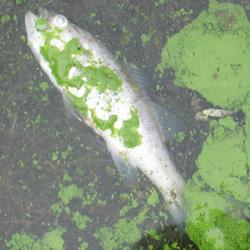Are Naturally Occurring Algal Toxins in Water Resources a Health Hazard?
USGS scientists retrieve and process samples
Cyanobacterial bloom in Kabetogama Lake, Minnesota
2016 Cyanobacterial blooms on Lake Okeechobee, Florida
A growing number of human gastrointestinal, respiratory, dermatologic, and neurologic effects, as well as dog and livestock illnesses and deaths, in the United States have been linked to exposures to algal blooms in recreational lakes and stock ponds.
Some of the blooms contain cyanobacteria, which have the potential to produce cyanotoxins in freshwater systems. However, the connection between illnesses and cyanotoxin exposure is largely anecdotal.
Our specialized teams of hydrologists, chemists, biologists, and geologists working in laboratories and at field sites across the United States have shown that cyanotoxins are present in rivers, lakes, and wetlands across the United States.
Understanding the factors driving toxin production and the health risks from cyanotoxin exposures are important for safeguarding human and animal health and managing our aquatic resources more effectively.
Questions We're Working On:
- Identify factors related to cyanotoxin production
- Determine if cyanotoxins associated with algal blooms are causing a significant health hazard to humans, pets, livestock, or wildlife
- Develop early-warning indicators of toxic cyanobacterial blooms

Below are other science projects associated with this project.
Algal and Environmental Toxins Research Laboratory — Lawrence, Kansas
Toxins and Harmful Algal Blooms Science Team
A growing number of human gastrointestinal, respiratory, dermatologic, and neurologic effects, as well as dog and livestock illnesses and deaths, in the United States have been linked to exposures to algal blooms in recreational lakes and stock ponds.
Some of the blooms contain cyanobacteria, which have the potential to produce cyanotoxins in freshwater systems. However, the connection between illnesses and cyanotoxin exposure is largely anecdotal.
Our specialized teams of hydrologists, chemists, biologists, and geologists working in laboratories and at field sites across the United States have shown that cyanotoxins are present in rivers, lakes, and wetlands across the United States.
Understanding the factors driving toxin production and the health risks from cyanotoxin exposures are important for safeguarding human and animal health and managing our aquatic resources more effectively.
Questions We're Working On:
- Identify factors related to cyanotoxin production
- Determine if cyanotoxins associated with algal blooms are causing a significant health hazard to humans, pets, livestock, or wildlife
- Develop early-warning indicators of toxic cyanobacterial blooms

Below are other science projects associated with this project.



